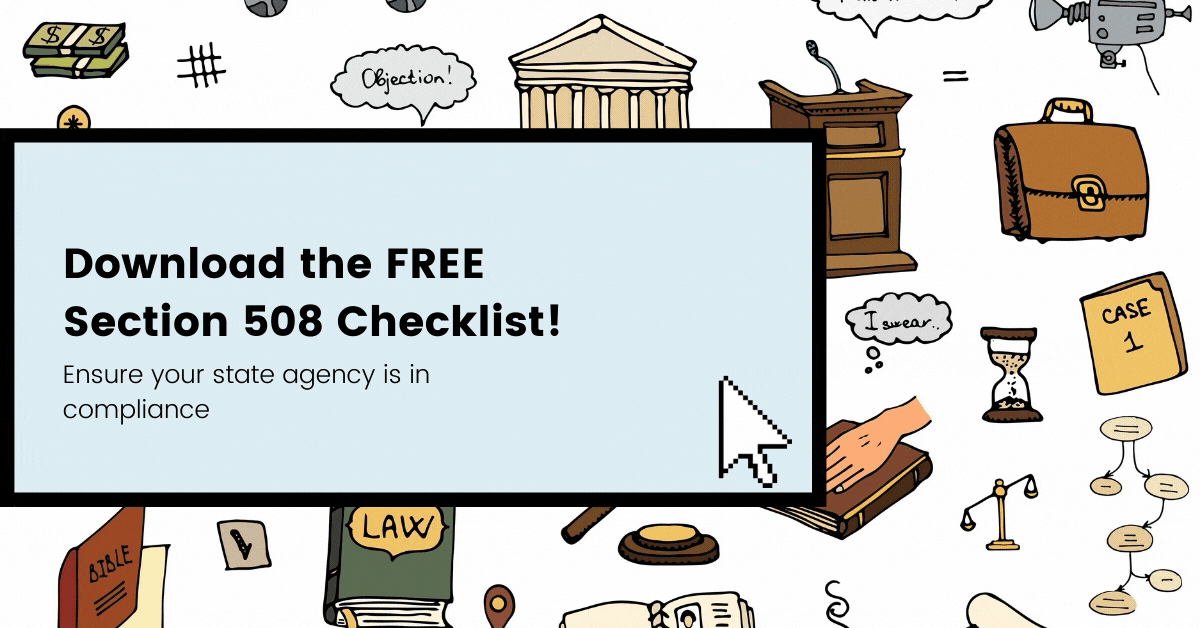Arkansas State Web Accessibility Laws
Updated: October 20, 2023
The State of Arkansas recognizes that “individuals who are blind or visually impaired have the right to full participation in the life of the state.” This is reflected in several Arkansas state web accessibility laws, outlined in this post.
All Arkansas government or state-funded entities are required to have websites that are “equally accessible to blind or visually impaired visitors.”
The Arkansas government defines information technology products and services as, “data, voice, and video technologies, as well as information dissemination methods such as the Internet.”
“Act 1227 of 1999 required the Arkansas Department of Information Systems to develop Non-visual Standards for Arkansas that ensure the needs of Arkansans who are blind or visually impaired are met through reasonable accommodation.”
Download The Section 508 Checklist ➡️
Act 1227 of 1999
Arkansas’s web accessibility policy is split into 10 sections. The act was approved on 4/8/1999.
A brief summary of each section is provided below. For the full policy, please refer to House Bill 2044, Act 1227 of 1999.
- Section 1 Findings and policy: Establishes a requirement for all information technology to include nonvisual alternatives for the blind and visually impaired.
- The goal of this act is to ensure even the most advanced forms of information technology include universal access to all segments of society.
- All programs and technology supported in whole or in part by public funds must be made accessible to blind or visually impaired individuals.
- Section 2 Definitions: Includes a list of definitions defining the terms found in the act.
- Section 3 Assurance of non visual access: The head of each covered entity is in charge of ensuring “all information technology equipment and software used by employees, program participants, or members of the general public provides blind and visually impaired individuals with access.”
- Purchased technology must included a technology access clause, which is outlined in Section 4 of the act.
- Section 4 Procurement requirements: All information technology purchases need to include a technology access clause in all contracts. Further requirements are outlined in the act.
- Section 5 Implementation: Any new technology, such as equipment and software, purchased must include the technology access clause. In addition, technology purchased prior to the act, must comply with the act once it is renewed or replaced.
- Section 6 Action for injunction: Any person “injured by a violation of this act may maintain an action for injunctive relief to enforce the terms of this act.”
- Section 7 This act is to take effect from the date of enactment.
- Section 8 All provisions of this act are permanent and mandatory under the Arkansas Code of 1987 Annotated.
- Section 9 References invalidities of the act.
- Section 10 “All laws and part of laws in conflict with this act are hereby repealed.”
Check Out The Section 508 Checklist!
Act 1227 Amended by Act 308
Act 1227 of 1999 was amended by Act 308 in 2013. This update mandated that State of Arkansas electronic and information technology purchases (purchased either in whole or in part with state funds) must be accessible to individuals who are blind or low vision as specified by standards listed in the act.
In amending the Act of 1227, the state of Arkansas found that with the information age in the US and around the world a lot has changed in information technology since 1999 and accessibility has often been overlooked. It is stated, “It is the policy of the State of Arkansas that all programs and activities which that are supported in whole or in part by public funds shall be conducted in accordance with the following principles:”
- To the extent provided in this subchapter, individuals who are blind or visually impaired shall be provided access to the advanced technology that is provided access to other employees, program participants, and members of the general public;
- To the extent provided in this subchapter, technology purchased in whole or in part with funds provided by the state to be used for the creation, storage, retrieval, or dissemination of information and intended for use by employees, program participants, and members of the general public shall be accessible to and usable by individuals who are blind or visually impaired;
- If technology that allows access for individuals who are blind or visually impaired is not reasonably available, individuals who are blind or visually impaired shall be provided a reasonable accommodation as defined in 42 U.S.C. § 12111(9), as it existed on January 1, 2013.
Note: The phrase “equivalent access” refers to assistive technologies or other accommodations which would constitute reasonable accommodations under the Americans with Disabilities Act or similar state and federal laws.
One caveat of Act 308 is the following language, which unfortunately provides an easy exemption: “If the information manipulated or presented by the product is inherently visual in nature so that its meaning cannot be conveyed non‐visually, these specifications do not prohibit the purchase or use of an information technology product that does not meet these standards.”
__
Learn About Other U.S. State Accessibility Laws
Read this blog post to learn more about captioning and web accessibility laws in other states.
Want to know if your Arkansas state agency is compliant with web accessibility standards?









